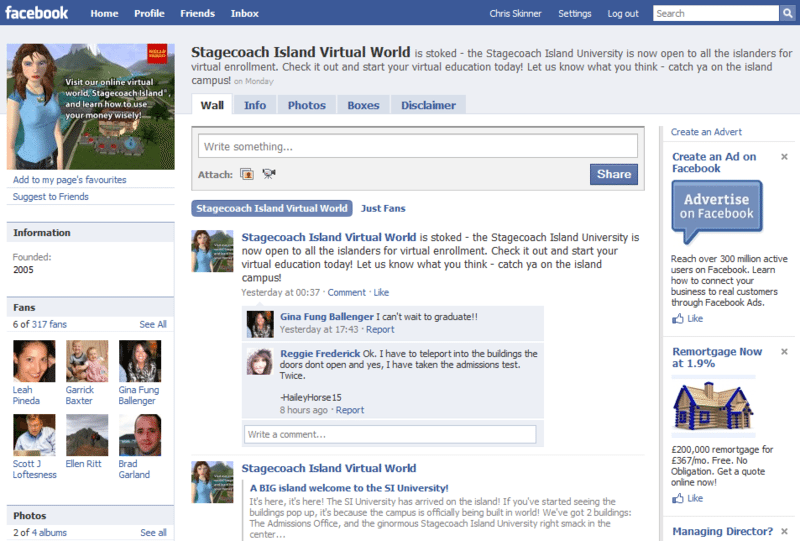
I've blogged a lot about Wells Fargo's innovations in the past.
This is because they are one of the banks in the stream of innovation that comes out of Silicon Valley. This is why they are great proponents of social media:
- Blogging: FIVE corporate blogs.
- Online video: YouTube channel.
- Social networks: MySpace profile for Cassie, from Stagecoach Island.
- Facebook Stagecoach Island application and fan page.
- Virtual worlds: Stagecoach Island.
Stagecoach Island is one of their key platforms in this space.
Stagecoach Island was first piloted in September 2005 to provide financial education in a fun and engaging way.
Initially, it was piloted in Second Life but, after some issues over virtual hackers and bombers, Wells Fargo moved Stagecoach Island onto their own platform in 2006.
Three years later, it is still going, with its own community, blog and facebook fanbase.

So I was intrigued yesterday when I saw that they’ve just launched the Stagecoach Island University (the official launch was on November 30th).
What’s this I wondered?
And so I asked Tim Collins, who looks after Experiential Marketing at Wells Fargo, to tell all. I also gave him a hard time over some of the sceptics’ views on the value of these developments.
Here’s our chat:
Tim: We continue to be happy with the results of Stagecoach Island and invest in new features every year. We have tens of thousands of members and see double digit growth in membership every year. Engagement is also growing, as our session lengths are approaching an hour.
We are about to launch Stagecoach Island University, which was created in partnership with Educational Financial Services and WF Foundation. The “Admissions” module expands the Stagecoach Island curriculum to include saving for college, financial aid, tips for budgeting and information on funding post secondary education. The “University” content provides direct access to the entire young adult and adult sections of Hands on Banking in a virtual space.
To add a user incentive component and incorporate real world lessons, once members complete their university experience and pass a comprehensive exit exam, they will be eligible for a new tier of “high-level” jobs within Stagecoach Island, each of which requires the completion of Stagecoach Island University.
Chris: In other words, by completing the Stagecoach Island University examinations, users become more knowledgeable about their finances and use of money, and should be better capable of managing budgets, borrowings and investments.

Tim: That’s right.
Chris: But the sceptics out there always ask me the same questions about this stuff.
Tim: Such as?
Chris: Well, the first question would be: why would a bank keep investing in Virtual Worlds as most virtual world experiments, such as all the banking trials in Second Life, are dead and gone. Isn’t this a broken business model?
Tim: I don’t think it’s fair to compare Stagecoach Island to Second Life. It’s like comparing a private community to the entire blogosphere. Stagecoach Island is a private community with an educational purpose. Second Life has a generalist business model in a world that is increasingly specialized. They are adapting, but since their data security breach, I doubt many financial services companies will want to engage with them.
Chris: OK, even if this is worth doing, aren’t all the users young, zero profit students, or are there any real people on Stagecoach Island?
Tim: Our average age for a user is 23 years old, but we have learned that our members are much more profitable than your average 23 year old. They have higher balances, more products, and will recommend us to their friends. And did I mention their great dental hygiene :-)
Chris: Can you provide any proof points that show this to be a worthwhile venture?
Tim: I think I just did.
Chris: Maybe, but every time I mention what you’re doing to others, those are the questions I get.
Tim: I’m not surprised. Bankers are a literal audience. They want to see a direct cause and effect. If they spend a dollar on marketing today, how much will I get in sales and profits tomorrow? Experiential Marketing is different. It doesn’t directly support the sales process. Rather, it’s the warm up act for the sales process.
If we invest the time and effort to educate consumers, whether they be our customers or not, they will think kindly of us when it comes time to doing their banking. It will make the sales process easier, and we will make more money.
We have proved this with project after project....social media as a prime example. I think you are getting these questions because many companies don’t have the patience.
Chris: Thanks Tim, and good luck with it all.
Chris M Skinner
Chris Skinner is best known as an independent commentator on the financial markets through his blog, TheFinanser.com, as author of the bestselling book Digital Bank, and Chair of the European networking forum the Financial Services Club. He has been voted one of the most influential people in banking by The Financial Brand (as well as one of the best blogs), a FinTech Titan (Next Bank), one of the Fintech Leaders you need to follow (City AM, Deluxe and Jax Finance), as well as one of the Top 40 most influential people in financial technology by the Wall Street Journal's Financial News. To learn more click here...


